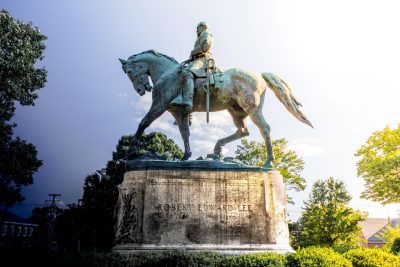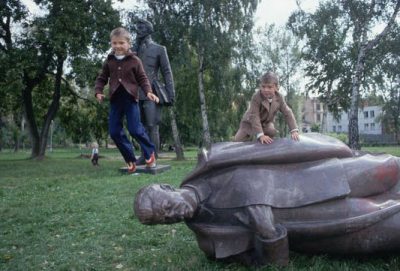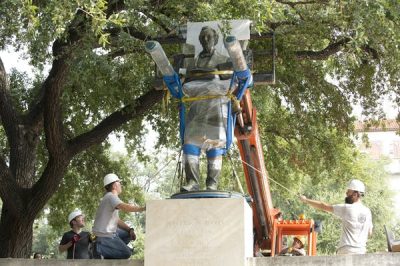Editor’s Note: The following piece, co-authored by Professor Alan Marcus and Walter Woodward, associate professor in the College of Liberal Arts and Sciences and Connecticut State historian, was originally published in The Conversation.

Historical monuments are intended to be timeless, but almost all have an expiration date. As society’s values shift, the legitimacy of monuments can and often does erode.
This is because monuments – whether statues, memorials or obelisks – reveal the values of the time in which they were created and advance the agendas of their creators.
Many 9/11 monuments in the U.S., for example, serve both to remember and honor victims of the attacks while promoting national vigilance. These views garnered nearly universal support immediately after the attacks. Over time, however, as the costs and consequences of “homeland security” became clearer, unqualified support for this agenda has waned.
Current debates around racism confirm that Confederate statues and Christopher Columbus statues, both of which effectively commemorate white superiority, have expired, too.
The question then becomes: What’s a nation to do with expired monuments?
“Over the past century, American public officials, citizens and historians have taken one of two paths. They either ignored expired monuments – the 20th-century approach – or, more recently, rejected them.”
Purpose of monuments

Over the past century, American public officials, citizens and historians have taken one of two paths. They either ignored expired monuments – the 20th-century approach – or, more recently, rejected them.
Ignoring problem monuments left the impression among many that officials endorsed the views they embodied. Today, people who see a host of monuments as illegitimate symbols of racism, authoritarianism and oppression have rejected this official indifference. Through protest or policy change, they have forced more open and productive discussions about race in America. Ultimately, many offensive monuments have been removed.
Removal eliminates the symbols of now-rejected values. But as historians and educators who have explored the instructive value of monuments, we believe statue removal can also limit the important conversations underway about their expired agendas.
Monuments provide an especially useful educational service because they serve double duty. They mark historical events or figures – the Battle of Bunker Hill, say, or Martin Luther King Jr.– and reflect the prevailing values of the time in which they were created. Monuments are also unique compared with other forms of cultural expression like art or literature in that they almost always reside in public spaces and are found in practically every town and city in America.
These attributes make monuments ideal launching points for helping society assess its current values and compare them with what mattered in the past.
Expired monuments are a lesson: They teach that people can be tragically wrong about something even when that belief once had widespread public support and official approval. Simultaneously, they show that radical, marginalized or contrary voices can turn out to be right. Or they may be, like their opponents, creatures of a particular moment in time.
Reinventing monuments

We’ve been studying how the function of expired monuments might be entirely reinvented so that their outdated agendas provide a cautionary tale.
Many thinkers, artists and public officials have put forward suggestions.
A common idea is to move expired monuments to museums, where they would be recast as art or as historic artifacts. The most creative proposals include making a Confederate statues “graveyard” or moving expired monuments to a sculpture park.
In all these settings, expired monuments would be stripped of the seal of official endorsement and clearly explained as once-venerated symbols of views now understood to be morally unacceptable. That raises larger questions about how societies can be blind to their own moral failures.
European countries offer some examples of how statues from painful chapters of history can be, as artist Jonathan Keats put it, “forcefully repositioned in a radically new context.”
Gorky Park in Moscow contains an area displaying old Soviet-era monuments that deprives them of their symbolic power. Statues of dictators Stalin and Lenin are no longer in a prominent public location and are clumped together in an apolitical manner.
In Estonia, old Soviet-era monuments are part of a history-rich museum exhibition that uses these relics of authoritarianism as a warning to future generations.
In post-World War II Germany, virtually all monuments to Hitler and the Third Reich were destroyed; perhaps some crimes are simply too abhorrent to be remembered so soon. But in 1986 an unusual monument against fascism was erected in Hamburg. Each year a portion of this vertical gray column was lowered underground until by 1993 it was completely gone. The 39-foot monument “disappeared” before it could expire.
The sunken monument can still be viewed underground. This tactic communicates that society needs to remember the dangers of fascism, but that a monument is not enough. Ultimately, only engaged citizens can attack injustice.
From valorizing to analyzing
Reinventing expired monuments uses outdated objects to teach about a society’s past values while assessing – and perhaps challenging – its contemporary beliefs. In other words, it moves from valorizing monuments to analyzing them.
That’s rich terrain for educators. Teachers can use reinvented monuments to ask students to consider the validity of what American society believes, says and does.
Monuments expire because views change. But because present-day cultural values are themselves often difficult for people to see from another perspective, analyzing monuments also has the educational value of prompting deliberations about how future generations will reflect upon today’s United States. How did this generation of Americans grapple with issues like racial injustice, climate change and economic inequality?
Future generations will hold current society to account, just as Americans today are scrutinizing the views and actions of past generations.
Reinventing rather than simply removing monuments requires confronting the past, recognizing current conditions and planning for the future – all while embracing the reality that historical change is a complex, messy and malleable process.
 Facebook
Facebook
 Twitter
Twitter
 LinkedIn
LinkedIn
